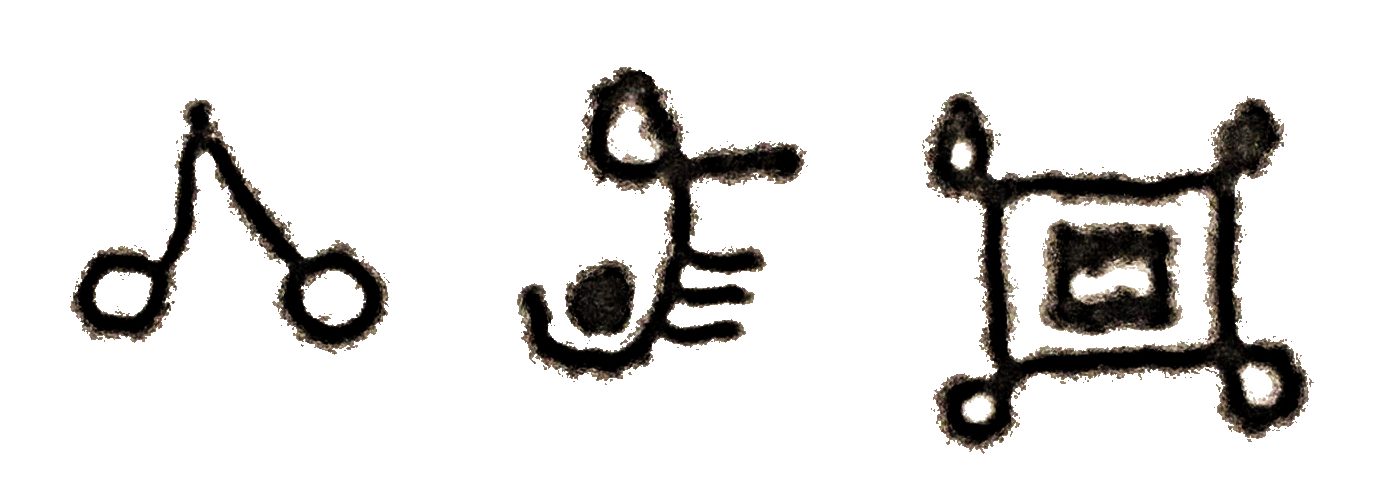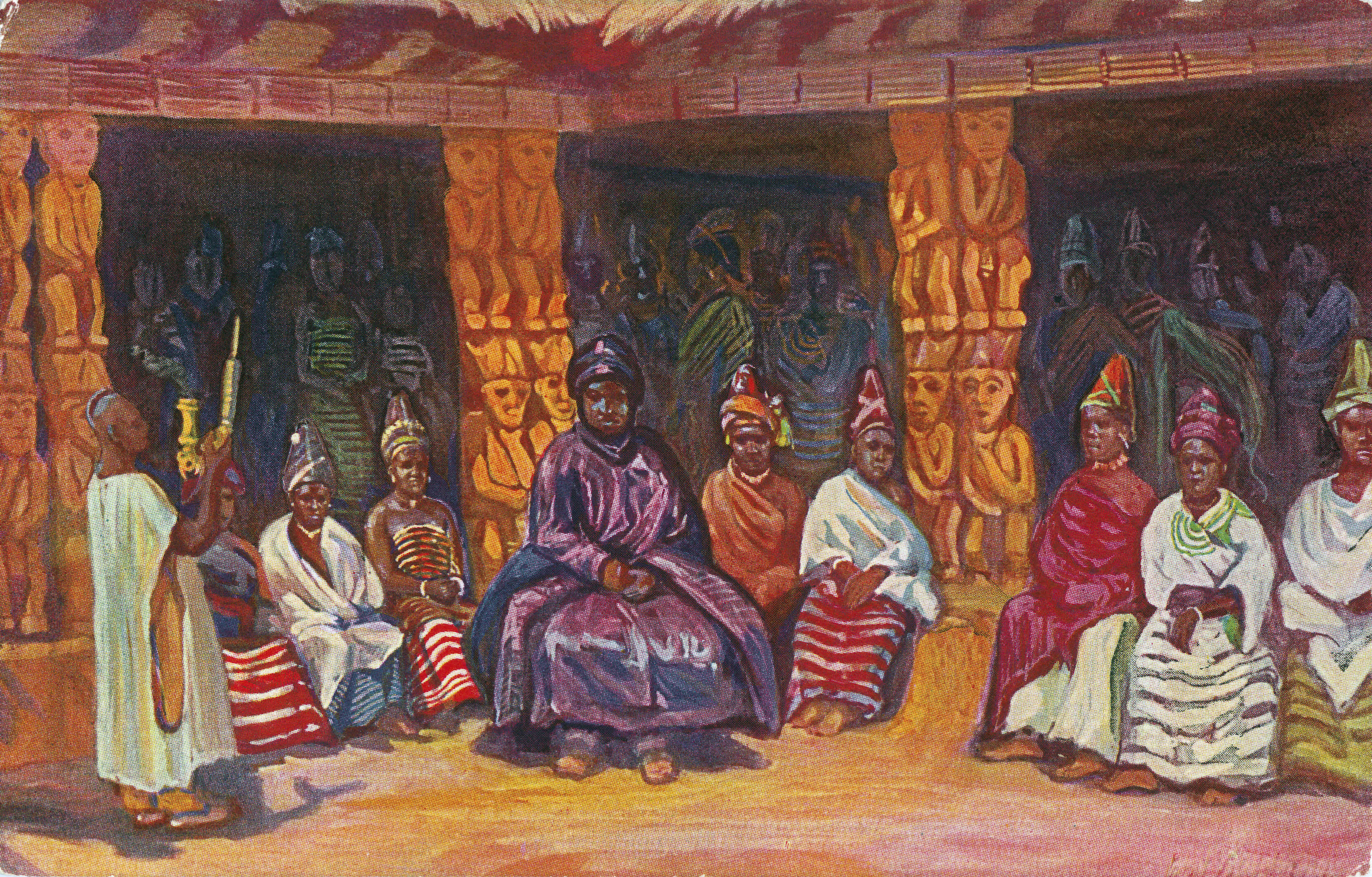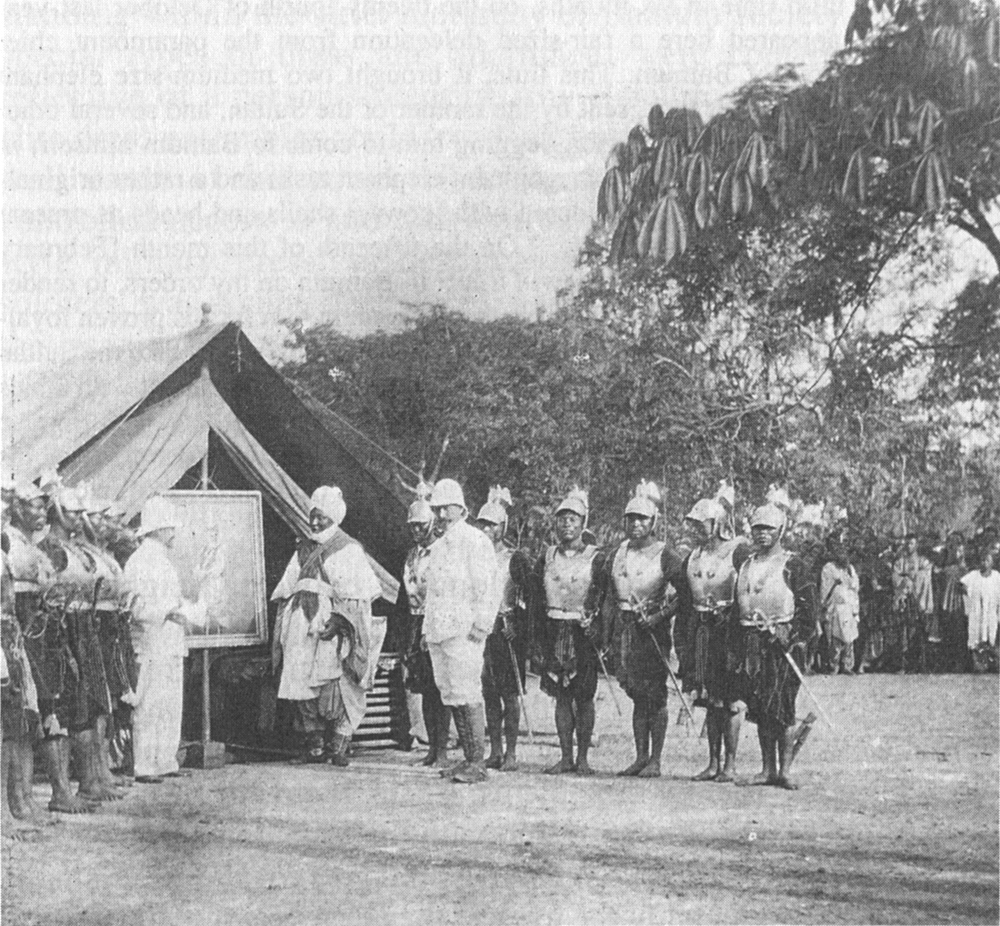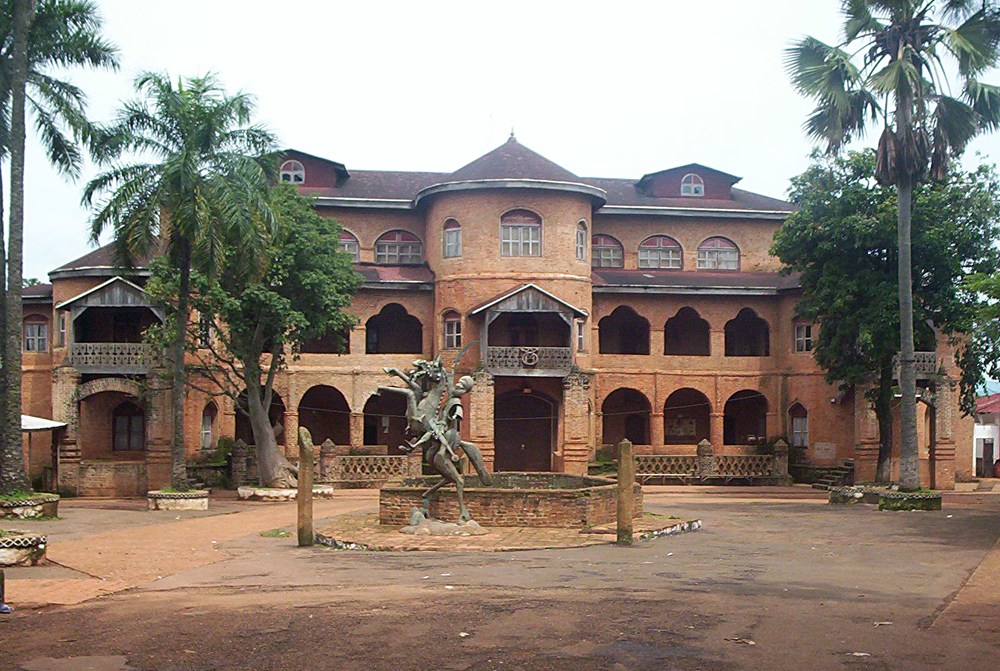Ibrahim Njoya on:
[Wikipedia]
[Google]
[Amazon]
King Ibrahim Mbouombouo Njoya ( Bamum: , ''Iparəim Nʃuɔiya'', formerly spelled in Bamum as  , and Germanicized as ''Njoja'') in
, and Germanicized as ''Njoja'') in
 Njoya was born circa 1876. His father passed away when he was just three years old, and his mother ruled the kingdom until he could ascend to the throne at the age of 11.
Colonel Gorges of the British Army, who met Njoya in 1914, described him thus as "a fine upstanding man."Gorges (1930) He practised
Njoya was born circa 1876. His father passed away when he was just three years old, and his mother ruled the kingdom until he could ascend to the throne at the age of 11.
Colonel Gorges of the British Army, who met Njoya in 1914, described him thus as "a fine upstanding man."Gorges (1930) He practised
 Njoya's mother, Njapdunke, acted as regent until he reached majority. His official rule was further delayed because his father's head was held by an old adversary, the
Njoya's mother, Njapdunke, acted as regent until he reached majority. His official rule was further delayed because his father's head was held by an old adversary, the
 Ibrahim Njoya is credited with developing the
Ibrahim Njoya is credited with developing the  Recognizing the inherent danger of important historical facts being omitted or corrupted, he set out to establish a means of written recording of Bamum history. When his work was completed, his alphabet, called, ''A-ka-u-ku'' based on its first four signs, contained 73 signs in total.
Njoya may have also invented a hand-powered mill for grinding corn and other cereals.
After initially starting the project in the 1980s, his grandson, Ibrahim Mbombo Njoya, a present-day Sultan in Cameroon and the latest ruler in the Bamoun Dynasty, has continued the transition of the palace into a museum, in which schoolchildren are learning the Bamum script developed by Ibrahim Njoya.
Recognizing the inherent danger of important historical facts being omitted or corrupted, he set out to establish a means of written recording of Bamum history. When his work was completed, his alphabet, called, ''A-ka-u-ku'' based on its first four signs, contained 73 signs in total.
Njoya may have also invented a hand-powered mill for grinding corn and other cereals.
After initially starting the project in the 1980s, his grandson, Ibrahim Mbombo Njoya, a present-day Sultan in Cameroon and the latest ruler in the Bamoun Dynasty, has continued the transition of the palace into a museum, in which schoolchildren are learning the Bamum script developed by Ibrahim Njoya.
Cameroon history
{{DEFAULTSORT:Njoya, Seidou Njimoluh 1860 births 1933 deaths Cameroonian traditional rulers Creators of writing systems
 , and Germanicized as ''Njoja'') in
, and Germanicized as ''Njoja'') in Yaoundé
Yaoundé (; , ) is the capital of Cameroon and, with a population of more than 2.8 million, the second-largest city in the country after the port city Douala. It lies in the Centre Region of the nation at an elevation of about 750 metres (2,50 ...
, was seventeenth in a long dynasty
A dynasty is a sequence of rulers from the same family,''Oxford English Dictionary'', "dynasty, ''n''." Oxford University Press (Oxford), 1897. usually in the context of a monarchical system, but sometimes also appearing in republics. A ...
of kings that ruled over Bamum and its people in western Cameroon
Cameroon (; french: Cameroun, ff, Kamerun), officially the Republic of Cameroon (french: République du Cameroun, links=no), is a country in west-central Africa. It is bordered by Nigeria to the west and north; Chad to the northeast; the C ...
dating back to the fourteenth century. He succeeded his father Nsangu, and ruled from 1886 or 1887 until his death in 1933, when he was succeeded by his son, Seidou Njimoluh Njoya
Seidou Njimoluh Njoya ( Bamum: ''Sɛt-tu Nʒemɔleʔ Nʒeɔya'' , 1902 – 28 July 1992)DeLancey and DeLancey 206. ruled the Bamum people of Cameroon from 1933 to 1992 as the Sultan of Foumban and Mfon of the Bamun. Njimoluh was the son of Ibr ...
. He ruled from the ancient walled city of Fumban.
Person and life
 Njoya was born circa 1876. His father passed away when he was just three years old, and his mother ruled the kingdom until he could ascend to the throne at the age of 11.
Colonel Gorges of the British Army, who met Njoya in 1914, described him thus as "a fine upstanding man."Gorges (1930) He practised
Njoya was born circa 1876. His father passed away when he was just three years old, and his mother ruled the kingdom until he could ascend to the throne at the age of 11.
Colonel Gorges of the British Army, who met Njoya in 1914, described him thus as "a fine upstanding man."Gorges (1930) He practised polygamy
Crimes
Polygamy (from Late Greek (') "state of marriage to many spouses") is the practice of marriage, marrying multiple spouses. When a man is married to more than one wife at the same time, sociologists call this polygyny. When a woman is ...
— Gorges reported that he had 600 wives and 149 children by 1915; it is thought that he had 177 children in all.
Under the influence of a German missionary, Njoya converted to Christianity
Christianity is an Abrahamic monotheistic religion based on the life and teachings of Jesus of Nazareth. It is the world's largest and most widespread religion with roughly 2.38 billion followers representing one-third of the global pop ...
. He later created a new syncretistic religion based on Christianity and traditional Bamum religion before converting to Islam along with much of his court in 1916. He accepted the authority of the Sokoto Caliph, requesting the caliph send him an emir's flag and Muslim teachers.
Rule
 Njoya's mother, Njapdunke, acted as regent until he reached majority. His official rule was further delayed because his father's head was held by an old adversary, the
Njoya's mother, Njapdunke, acted as regent until he reached majority. His official rule was further delayed because his father's head was held by an old adversary, the Nso people
The Nso people are from the Bamenda grass fields Northwest Region of Cameroon. Their traditional language is Lamnso (language of Nso) and their capital is Kumbo – where the Palace of the Fon is found.
Summary History
The Nso’ people migr ...
. (By tradition the head or skull of an ancestor is of ceremonial importance to the Bamum.) The Germans helped him in recovering the head and this, along with their allowing him relative independence, caused him to have generally good relations with them. Since the German colonizers after taking possession of Cameroon
Cameroon (; french: Cameroun, ff, Kamerun), officially the Republic of Cameroon (french: République du Cameroun, links=no), is a country in west-central Africa. It is bordered by Nigeria to the west and north; Chad to the northeast; the C ...
were advancing inland, the young King Njoya developed a strong interest in the culture of the new "fatherland". An additional factor seems to have been a belief that fighting the Germans would prove counterproductive to his people, hence he rejected the resistance proposals of Rudolf Duala Manga Bell
Rudolf Duala Manga Bell (1873 – 8 August 1914) was a Duala king and resistance leader in the German colony of Kamerun (Cameroon). After being educated in both Kamerun and Europe, he succeeded his father Manga Ndumbe Bell on 2 September 1908 ...
. He greeted the Germans with great celebrations in his residence in Foumban
Foumban or Fumban is a city in Cameroon, lying north east of Bafoussam. It has a population of 83,522 (at the 2005 Census). It is a major town for the Bamoun people and is home to a museum of traditional arts and culture. Foumban is known f ...
, which soon brought him the title of an official figure-holder of the German colonial government. King Njoya tried to maintain a good relationship with the German Empire during his lifetime. On the birthday of Kaiser Wilhelm II
, house = Hohenzollern
, father = Frederick III, German Emperor
, mother = Victoria, Princess Royal
, religion = Lutheranism (Prussian United)
, signature = Wilhelm II, German Emperor Signature-.svg
Wilhelm II (Friedrich Wilhelm Viktor ...
, he had given him the throne from the governor of Buea
Buea is the capital of the Southwest Region of Cameroon. The city is located in Fako Division, on the eastern slopes of Mount Cameroon, and has a population of 300,000 (at the 2013 Census). It has two Government Hotels, the Mountain Hotel and ...
. This put Njoya in the Kaiser's favor, and enabled Felix von Luschan
Felix Ritter von Luschan (11 August 1854 – 7 February 1924) was an Austrian doctor, anthropologist, explorer, archaeologist and ethnographer.
Life
Luschan was born the son of a lawyer in Hollabrunn, Lower Austria, and attended the Akademische ...
, director of the Berlin Museum of Ethnology, to exhibit the throne, which had been imprinted with dyed pearls in great skill. To this day the throne can still be seen in the Berlin Ethnological Museum.Joachim Zeller: ''Kunstwerke aus deutschen Kolonien im Ethnologischen Museum.'' In: Joachim Zeller, Ulrich Van der Heyden: ''Kolonialmetropole Berlin - Eine Spurensuche.'' Berlin-Edition, Berlin 2002, , 281 pp. In return Wilhelm II sent for, as he put it, his ''königlichen Bruder'' (royal brother), a German Cuirassier uniform of the German Imperial Guard. Like an oil painting of Wilhelm II, the uniform is now exhibited in the Palace Museum at Foumban.
Njoya was convinced that German culture
The culture of Germany has been shaped by major intellectual and popular currents in Europe, both religious and secular. Historically, Germany has been called ''Das Land der Dichter und Denker'' (the country of poets and thinkers). German cult ...
and Bamun culture were compatible. In cooperation with the German administration, he set up schools in which the Bamun children extended their knowledge of their mother tongue, learned the Bamun script introduced by Njoya, and also passed on basic knowledge of the German language
German ( ) is a West Germanic language mainly spoken in Central Europe. It is the most widely spoken and official or co-official language in Germany, Austria, Switzerland, Liechtenstein, and the Italian province of South Tyrol. It is als ...
.
Col. Gorges noted in 1914 that he held court or ''durbar'' daily outside the gatehouse for the dispensing of justice and receipt of tribute, and that all his people had access to him. There was a very well-defined code of court etiquette observed:"Any courtier wishing to speak to him assumes a cringing attitude, removes his skull-cap, clasps his hands and, taking a chukker round behind the presence, finally arrives at the royal elbow. Here he averts his head and makes his request in a hoarse whisper. When the king coughs or clears his throat everyone present softly claps his hands."In 1917, Njoya demolished the old palace built in traditional wooden architecture of the Bamun and built a new residence in Prussian brick style in its place. In 1916, the French had taken control of German Cameroon, and the Kingdom of Bamun lost its partial autonomy. Since Njoya resided in
Foumban
Foumban or Fumban is a city in Cameroon, lying north east of Bafoussam. It has a population of 83,522 (at the 2005 Census). It is a major town for the Bamoun people and is home to a museum of traditional arts and culture. Foumban is known f ...
until 1931, despite his formal abolition by France, he had, in a ''de facto
''De facto'' ( ; , "in fact") describes practices that exist in reality, whether or not they are officially recognized by laws or other formal norms. It is commonly used to refer to what happens in practice, in contrast with ''de jure'' ("by la ...
'' sense, still had assumed the role as the king. Also in 1931, he was sent to Yaoundé
Yaoundé (; , ) is the capital of Cameroon and, with a population of more than 2.8 million, the second-largest city in the country after the port city Douala. It lies in the Centre Region of the nation at an elevation of about 750 metres (2,50 ...
, where he died two years later in 1933 at the age of 66. His successor was Seidou Njimoluh Njoya
Seidou Njimoluh Njoya ( Bamum: ''Sɛt-tu Nʒemɔleʔ Nʒeɔya'' , 1902 – 28 July 1992)DeLancey and DeLancey 206. ruled the Bamum people of Cameroon from 1933 to 1992 as the Sultan of Foumban and Mfon of the Bamun. Njimoluh was the son of Ibr ...
.
Innovations
 Ibrahim Njoya is credited with developing the
Ibrahim Njoya is credited with developing the Bamum script
The Bamum scripts are an evolutionary series of six scripts created for the Bamum language by Ibrahim Njoya, King of Bamum (now western Cameroon) at the turn of the 19th century. They are notable for evolving from a pictographic system to a s ...
, a semi-syllabic
Syllabic may refer to:
*Syllable, a unit of speech sound, considered the building block of words
**Syllabic consonant, a consonant that forms the nucleus of a syllable
*Syllabary, writing system using symbols for syllables
*Abugida, writing system ...
system for writing in the Bamum language
Bamum (Shü Pamom "language of the Bamum", or ''Shümom'' "Mum language"), also spelled Bamun or in its French spelling Bamoun, is an Eastern Grassfields language of Cameroon, with approximately 420,000 speakers. The language is well known for ...
. Before his reign, the long history of the Bamum people was preserved primarily through oral transmission from one generation to the next in the manner of the African Griot
A griot (; ; Manding: jali or jeli (in N'Ko: , ''djeli'' or ''djéli'' in French spelling); Serer: kevel or kewel / okawul; Wolof: gewel) is a West African historian, storyteller, praise singer, poet, and/or musician.
The griot is a repos ...
tradition. (This was largely true of many other African civilizations of the time.)
 Recognizing the inherent danger of important historical facts being omitted or corrupted, he set out to establish a means of written recording of Bamum history. When his work was completed, his alphabet, called, ''A-ka-u-ku'' based on its first four signs, contained 73 signs in total.
Njoya may have also invented a hand-powered mill for grinding corn and other cereals.
After initially starting the project in the 1980s, his grandson, Ibrahim Mbombo Njoya, a present-day Sultan in Cameroon and the latest ruler in the Bamoun Dynasty, has continued the transition of the palace into a museum, in which schoolchildren are learning the Bamum script developed by Ibrahim Njoya.
Recognizing the inherent danger of important historical facts being omitted or corrupted, he set out to establish a means of written recording of Bamum history. When his work was completed, his alphabet, called, ''A-ka-u-ku'' based on its first four signs, contained 73 signs in total.
Njoya may have also invented a hand-powered mill for grinding corn and other cereals.
After initially starting the project in the 1980s, his grandson, Ibrahim Mbombo Njoya, a present-day Sultan in Cameroon and the latest ruler in the Bamoun Dynasty, has continued the transition of the palace into a museum, in which schoolchildren are learning the Bamum script developed by Ibrahim Njoya.
See also
* Bamum people *Bamum kingdom
The Kingdom of Bamoun (also spelled Bamoum, Bamun, Bamoun, or Mum) (1394–c. 1916) is a pre-colonial Central African state in what is now northwest Cameroon. It was founded by the Bamun, an ethnic group from northeast Cameroon. Its capital was th ...
*List of Cameroonian artists
The following is a list of notable Cameroonian artists working in visual or plastic media (including 20th-century artists working in video art, performance art, or other types of new media). See other articles for information on Cameroonian Cultu ...
References
Further reading
*Gorges E.H. (1930) ''The Great War in West Africa'', Hutchinson & Co. Ltd., London; Naval & Military Press, Uckfield, 2004: *"A King of Great Accomplishments," ''Awake!
''Awake!'' is an illustrated religious magazine published by the Watch Tower Bible and Tract Society of Pennsylvania. It is considered to be a companion magazine of '' The Watchtower'', and is distributed by Jehovah's Witnesses. The Watch Tower S ...
'', December, 2007, pp. 26–27
*Alexandra Loumpet-Galitzine, ''Ibrahim Njoya, maître du dessin bamoun'' in ''Anthologie de l'art africain du XXe siècle'', eds. N'Goné Fall and Jean Loup Pivin, Revue Noire, Paris, 2001, pp. 102–105.
External links
Cameroon history
{{DEFAULTSORT:Njoya, Seidou Njimoluh 1860 births 1933 deaths Cameroonian traditional rulers Creators of writing systems